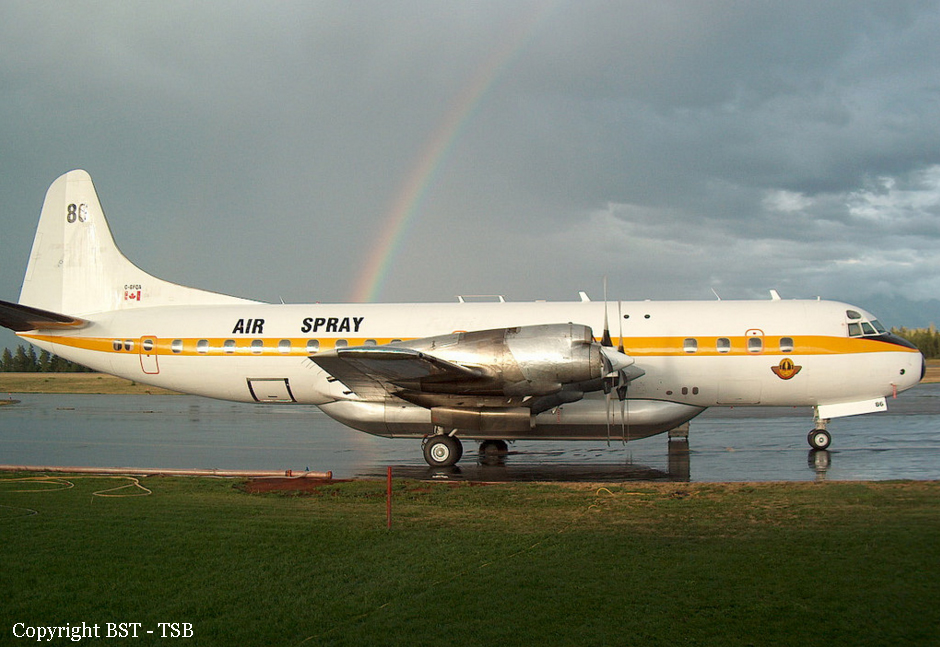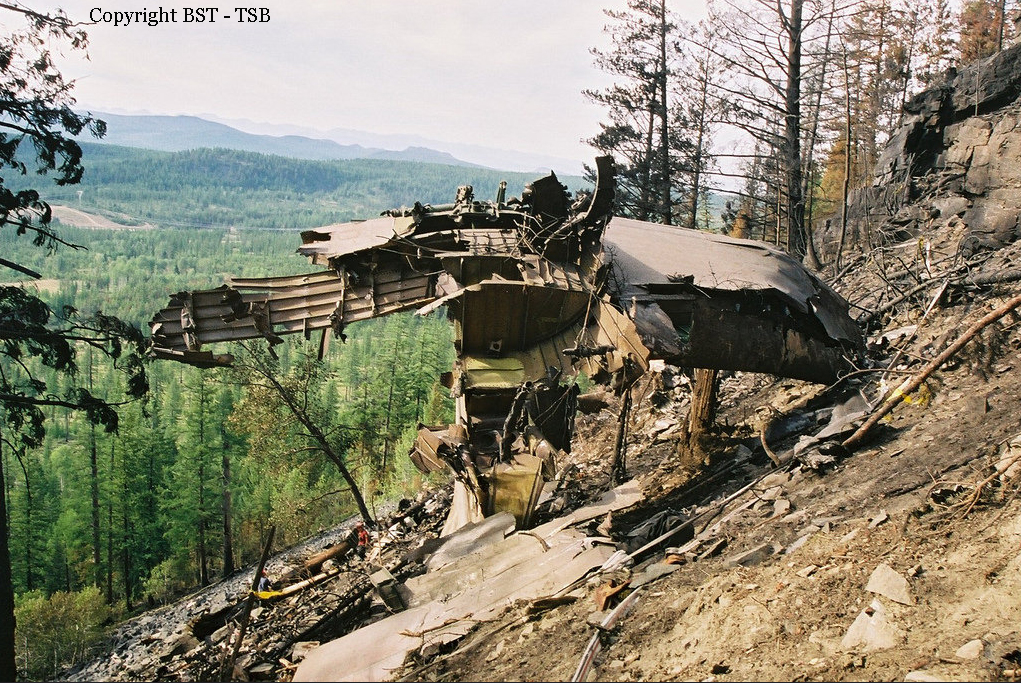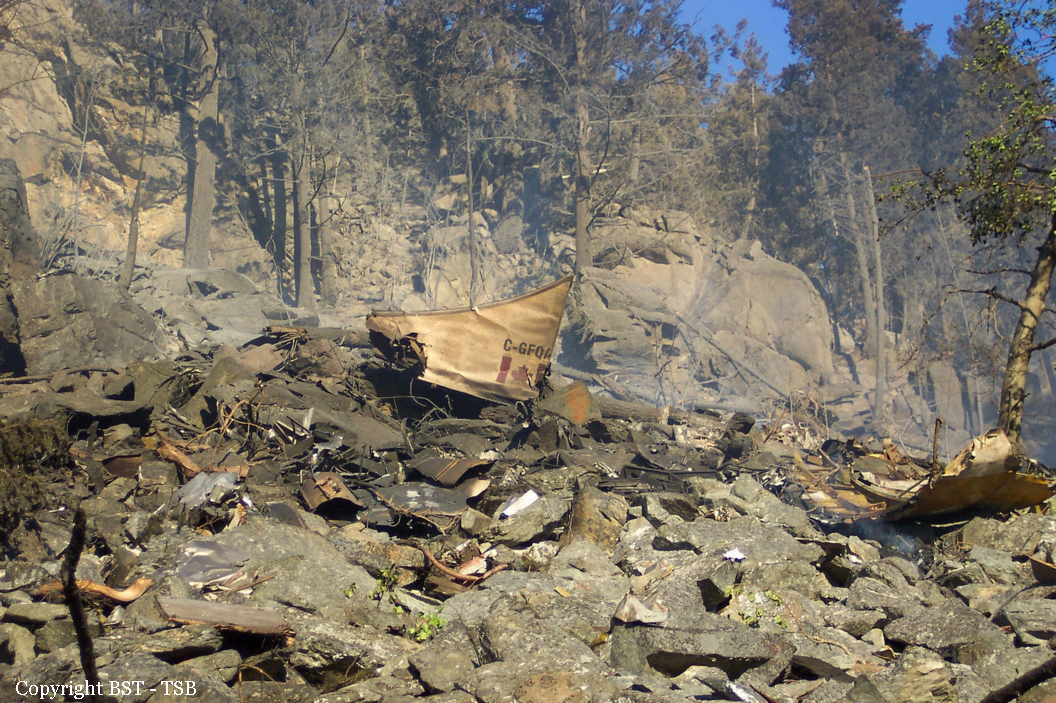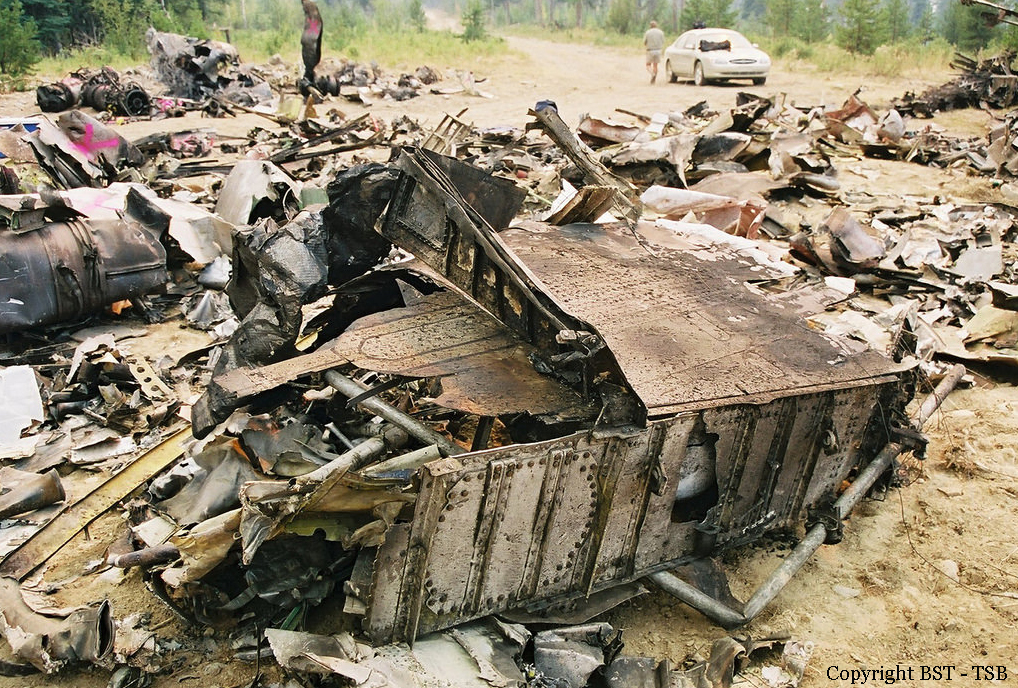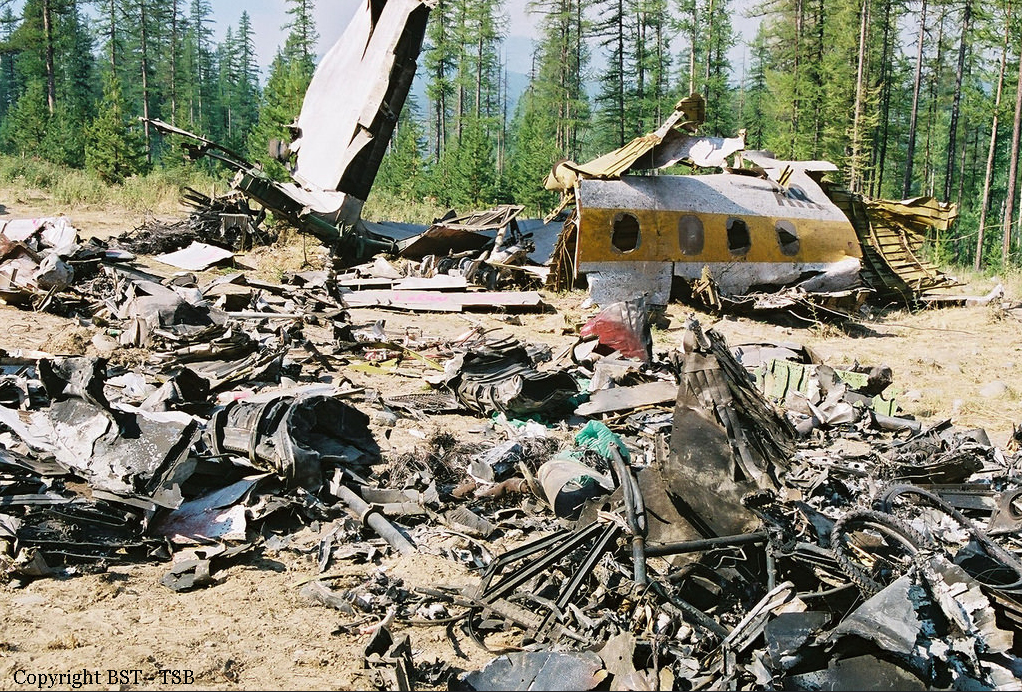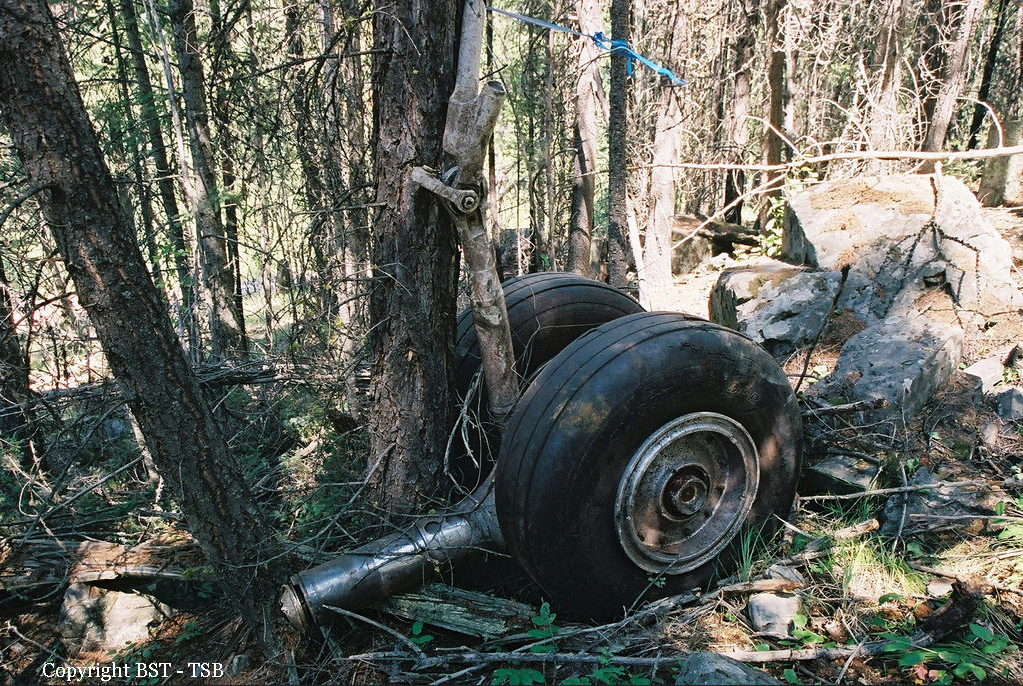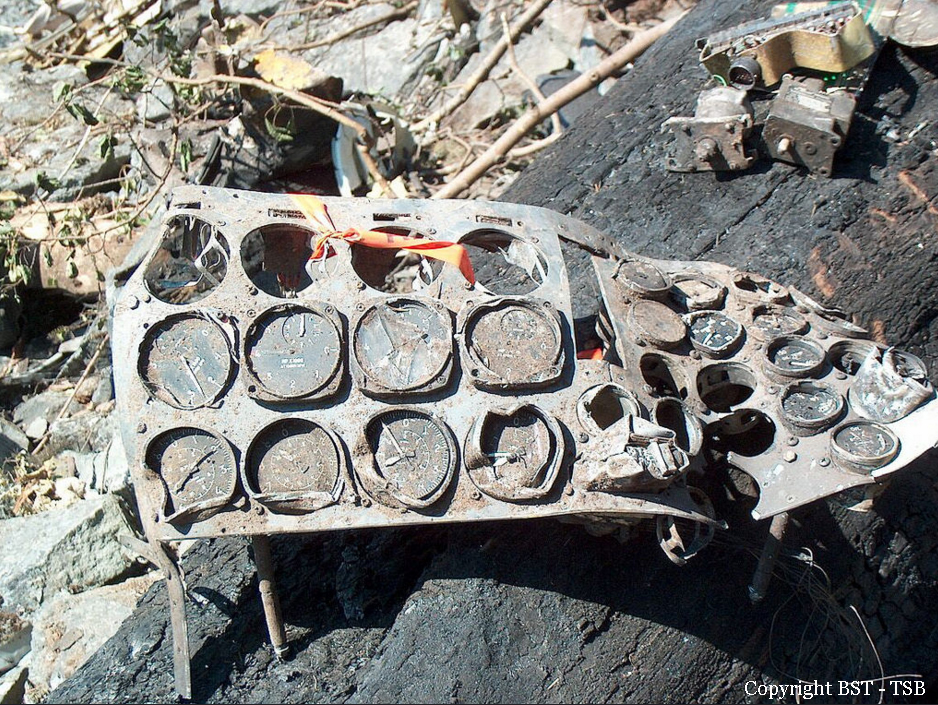Country
Crash of a Beechcraft 200 Super King Air in Squamish: 2 killed
Date & Time:
Jul 28, 2005 at 0840 LT
Registration:
C-FCGL
Survivors:
No
Schedule:
Vancouver – Smithers
MSN:
BB-190
YOM:
1976
Flight number:
NT202
Crew on board:
2
Crew fatalities:
Pax on board:
0
Pax fatalities:
Other fatalities:
Total fatalities:
2
Captain / Total hours on type:
100.00
Copilot / Total hours on type:
80
Circumstances:
A Raytheon Beechcraft King Air 200 (registration C-FCGL, serial number BB190) operating as NTA202 (Northern Thunderbird Air), departed Vancouver, British Columbia, at 0824 Pacific daylight time on 28 July 2005 for a visual flight rules flight to Smithers, British Columbia, with a crew of two on board. The aircraft did not arrive at its destination, and a search was commenced later that same day. The aircraft was found on 30 July 2005. The crash site was in a narrow canyon at an elevation of about 3900 feet above sea level, in an area of steeply rising terrain. Both occupants were fatally injured. A post-crash fire destroyed most of the aircraft. The emergency locator transmitter was destroyed in the fire and no signal was detected. The crash occurred at about 0840 Pacific daylight time.
Probable cause:
Findings as to Causes and Contributing Factors:
1. The aircraft was flown up a narrow canyon into rapidly rising terrain for reasons that could not be determined. The aircraft’s proximity to terrain and the narrowness of the canyon precluded a turn, and the aircraft’s climb rate was insufficient to clear the rising terrain.
2. The pilot decision-making training received by the crew members was ineffective because they were unprepared for the unique hazards and special operating techniques associated with flying low in mountainous terrain.
Finding as to Risk:
1. The company operations manual (COM) gave no guidance to the crew for the operation of a visual flight rules (VFR) flight, except for the provision that it should not be conducted closer to obstacles than 500 feet vertically and horizontally.
1. The aircraft was flown up a narrow canyon into rapidly rising terrain for reasons that could not be determined. The aircraft’s proximity to terrain and the narrowness of the canyon precluded a turn, and the aircraft’s climb rate was insufficient to clear the rising terrain.
2. The pilot decision-making training received by the crew members was ineffective because they were unprepared for the unique hazards and special operating techniques associated with flying low in mountainous terrain.
Finding as to Risk:
1. The company operations manual (COM) gave no guidance to the crew for the operation of a visual flight rules (VFR) flight, except for the provision that it should not be conducted closer to obstacles than 500 feet vertically and horizontally.
Final Report:
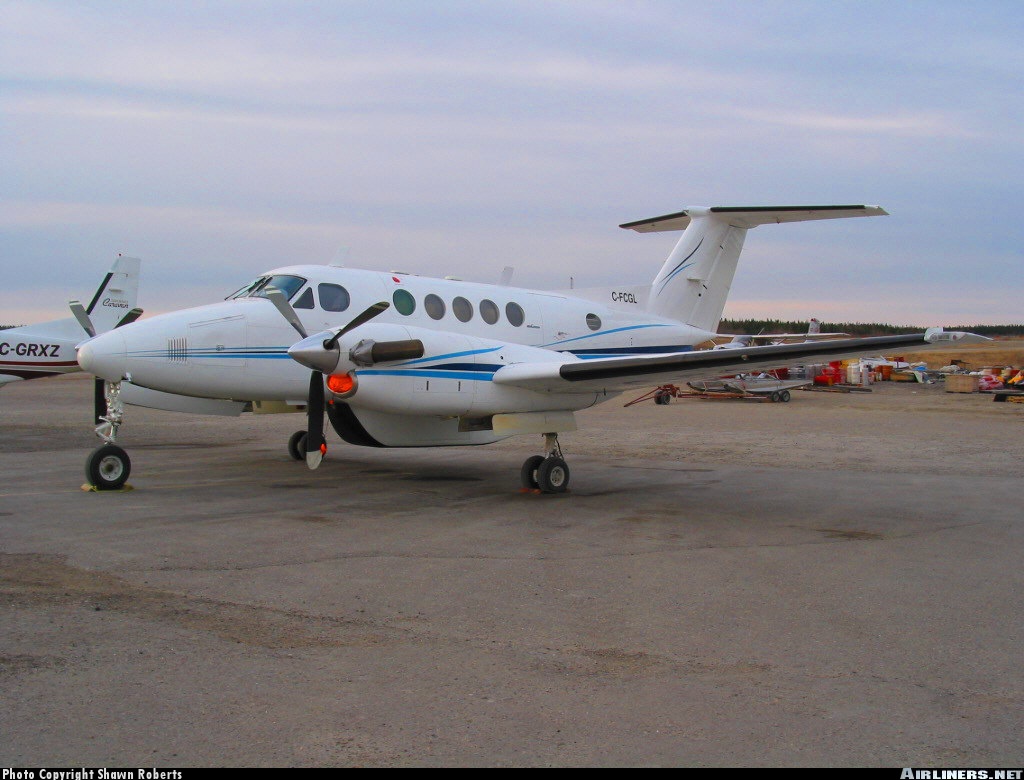

Crash of a Piper PA-31-350 Navajo Chieftain in Comox: 2 killed
Date & Time:
Apr 22, 2005 at 0741 LT
Registration:
C-GVCP
Survivors:
No
Schedule:
Nanaimo – Comox
MSN:
31-7652080
YOM:
1976
Crew on board:
2
Crew fatalities:
Pax on board:
0
Pax fatalities:
Other fatalities:
Total fatalities:
2
Circumstances:
The aircraft was on a scheduled cargo flight from Nanaimo, British Columbia, to the civilian terminal on the south side of the military airbase at Comox, British Columbia. The crew members established communication with the Comox tower when they were at about 2000 feet over Hornby Island, 12 nautical miles southeast of Comox, and requested a practice back course/localizer approach to Runway 30, circling for landing on Runway 18. The request was approved and the aircraft continued inbound. When the aircraft was about two miles from the threshold of Runway 30, the crew declared an emergency for an engine fire in the right engine. The tower alerted the airport response teams and requested standard data from the crew concerning the number of people and amount of fuel on board. Less than 30 seconds after the crew first reported the emergency, the aircraft was engulfed in flames. Shortly thereafter, at 0741 Pacific daylight time, the aircraft rolled inverted and struck the ground in a steep, nose-down, left-wing-low attitude. The aircraft broke apart and burned. Both crew members were fatally injured.
Probable cause:
Findings as to Causes and Contributing Factors:
1. At some point after 01 April 1999, a bad gasket (P/N LW-13388) was installed in the accident engine.
2. The requirement of Airworthiness Directive 2002-12-07 (to ensure that old converter plate gaskets were removed and replaced by new parts) was not carried out on the accident engine.
3. The improper oil filter converter plate gasket in the right engine compartment failed, allowing pressurized oil to spray into the engine compartment and ignite on contact with hot turbocharger and exhaust components.
4. The firewall fuel shut-off valve remained in the OPEN position, allowing pressurized fuel to be delivered to the engine-driven fuel pump by the aircraft’s boost pumps.
5. The initial oil-fed fire generated considerable heat, which melted the casing of the engine-driven fuel pump, allowing pressurized fuel to intensify the fire.
6. The flames breached the main fuel tank, inboard of the engine, causing the aircraft to become engulfed in flames.
Findings as to Risk:
1. Inappropriate converter plate gaskets, identified by part number LW-13388, are known to have remained in the aviation system after the date of the terminating action required by Airworthiness Directive (AD) 2002-12-07.
2. Compliance with the full requirements of AD 2002-12-07 is not always being accomplished with respect to vibro-peening and proper gluing procedures.
1. At some point after 01 April 1999, a bad gasket (P/N LW-13388) was installed in the accident engine.
2. The requirement of Airworthiness Directive 2002-12-07 (to ensure that old converter plate gaskets were removed and replaced by new parts) was not carried out on the accident engine.
3. The improper oil filter converter plate gasket in the right engine compartment failed, allowing pressurized oil to spray into the engine compartment and ignite on contact with hot turbocharger and exhaust components.
4. The firewall fuel shut-off valve remained in the OPEN position, allowing pressurized fuel to be delivered to the engine-driven fuel pump by the aircraft’s boost pumps.
5. The initial oil-fed fire generated considerable heat, which melted the casing of the engine-driven fuel pump, allowing pressurized fuel to intensify the fire.
6. The flames breached the main fuel tank, inboard of the engine, causing the aircraft to become engulfed in flames.
Findings as to Risk:
1. Inappropriate converter plate gaskets, identified by part number LW-13388, are known to have remained in the aviation system after the date of the terminating action required by Airworthiness Directive (AD) 2002-12-07.
2. Compliance with the full requirements of AD 2002-12-07 is not always being accomplished with respect to vibro-peening and proper gluing procedures.
Final Report:
Crash of a De Havilland DHC-2 Beaver off Quadra Island: 5 killed
Date & Time:
Feb 28, 2005 at 1916 LT
Registration:
C-GAQW
Survivors:
No
Schedule:
Campbell River – Frances Bay – Knight’s Inlet – Frances Bay – Campbell River
MSN:
1353
YOM:
1959
Crew on board:
1
Crew fatalities:
Pax on board:
4
Pax fatalities:
Other fatalities:
Total fatalities:
5
Circumstances:
The single engine aircraft departed Campbell River on a night flight to Knight's Inlet with four passengers and one pilot on board. As it failed to arrive at destination, SAR operations were initiated by RCAF & RCMP but no trace of the airplane and its occupants was found. On 15 of July 2005, the wreckage was found at a depth of 260 metres of Quadra Island by the families of the victims. TSB did not proceed to any investigations for this occurrence.


Crash of a De Havilland DHC-2 Beaver near Penticton: 3 killed
Date & Time:
Aug 29, 2003 at 1427 LT
Registration:
C-GHAF
Survivors:
No
Schedule:
Nanaimo - Penticton - Calgary
MSN:
1408
YOM:
1959
Crew on board:
1
Crew fatalities:
Pax on board:
2
Pax fatalities:
Other fatalities:
Total fatalities:
3
Captain / Total hours on type:
615.00
Aircraft flight hours:
9029
Circumstances:
The aircraft left Nanaimo, British Columbia, and landed at Penticton Airport at 1232 Pacific daylight time (PDT). The aircraft was fueled with 184 litres of fuel, filling all three belly tanks. At this time, the rear portion of the aircraft cabin was observed to be loaded with luggage and cargo. The pilot/aircraft owner was planning his flight to Calgary (Springbank), Alberta, and spent at least an hour flight planning and talking with the Kamloops Flight Information Centre by telephone. He had some difficulty determining a route to fly to Springbank, because of airspace restrictions due to forest fires, but decided on a routing of Penticton, Kelowna, Vernon, Revelstoke, and Springbank. The aircraft took off from Penticton Airport at 1420 PDT, with the pilot and two passengers on board and crashed approximately seven minutes later in a ravine of Penticton Creek, 11 nautical miles northeast of Penticton Airport. A post-impact fire broke out and consumed most of the fuselage area. The fire caused a small forest fire, seen by a firefighting aircraft crew. There were no radio calls from the occurrence aircraft, and the three occupants were fatally injured.
Probable cause:
Findings as to Causes and Contributing Factors:
1. As the aircraft approached high terrain in a climb, the pilot, for undetermined reasons, did not turn away from the terrain; the aircraft struck tree tops and crashed.
2. The aircraft’s climb performance was adversely affected by density altitude and the relatively high aircraft weight, so that the aircraft was unable to clear the high terrain ahead.
Findings as to Risk:
1. The licensed passenger had not informed the TC medical examiner who conducted her last medical that she had been diagnosed with coronary artery disease, posing the risk that she could pilot an aircraft while not medically fit to do so.
2. The aircraft was being operated at a higher weight than was justified by the STC, under which it was converted to an amphibian. Some of the structural modifications called for by the STC for the higher weight had not been carried out.
Other Findings:
1. It could not be determined who was piloting the aircraft on the occurrence flight.
1. As the aircraft approached high terrain in a climb, the pilot, for undetermined reasons, did not turn away from the terrain; the aircraft struck tree tops and crashed.
2. The aircraft’s climb performance was adversely affected by density altitude and the relatively high aircraft weight, so that the aircraft was unable to clear the high terrain ahead.
Findings as to Risk:
1. The licensed passenger had not informed the TC medical examiner who conducted her last medical that she had been diagnosed with coronary artery disease, posing the risk that she could pilot an aircraft while not medically fit to do so.
2. The aircraft was being operated at a higher weight than was justified by the STC, under which it was converted to an amphibian. Some of the structural modifications called for by the STC for the higher weight had not been carried out.
Other Findings:
1. It could not be determined who was piloting the aircraft on the occurrence flight.
Final Report:
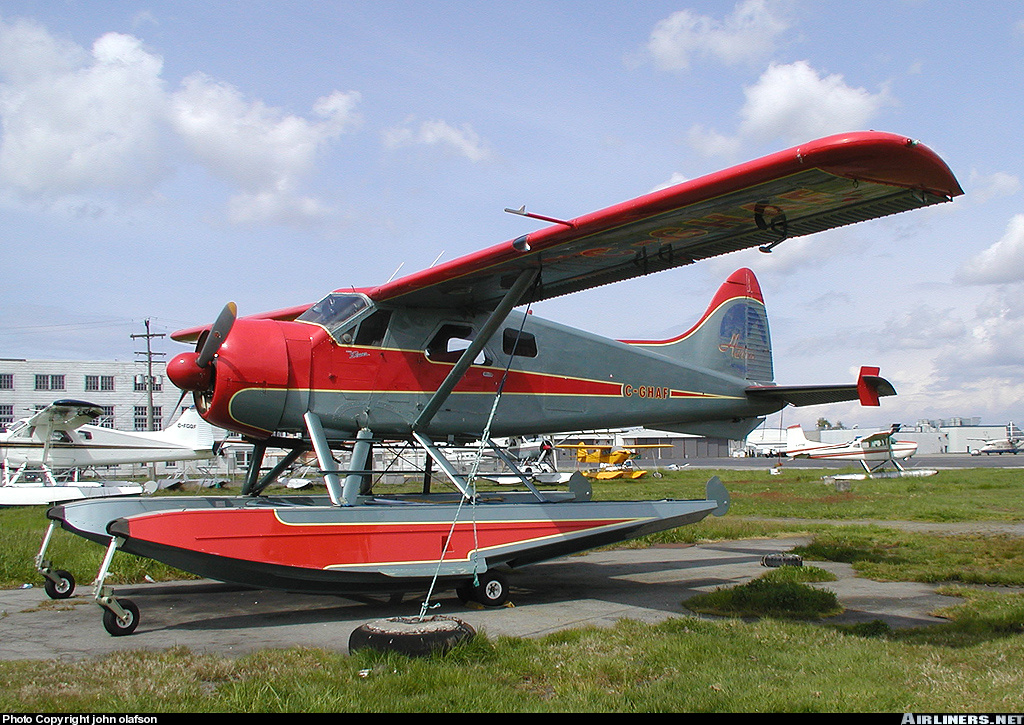
Crash of a Lockheed L-188A Electra in Cranbrook: 2 killed
Date & Time:
Jul 16, 2003 at 1221 LT
Registration:
C-GFQA
Survivors:
No
Schedule:
Cranbrook - Cranbrook
MSN:
1040
YOM:
1959
Flight number:
Tanker 86
Crew on board:
2
Crew fatalities:
Pax on board:
0
Pax fatalities:
Other fatalities:
Total fatalities:
2
Aircraft flight hours:
38775
Circumstances:
The aircraft took off from Runway 16 at the Cranbrook Airport, British Columbia. Two pilots were on board to conduct a fire-management mission on a small ground fire (designated N10156) two nautical miles southwest of the township of Cranbrook. Seven minutes earlier, the partner “bird dog” aircraft, a Turbo Commander, also departed Cranbrook to assess the appropriate aircraft flight path profiles and to establish the most suitable fire-retardant delivery program for the ground fire. Following the flight path demonstrations by the bird dog aircraft, Tanker 86 proceeded to carry out the retardant drop on the fire. After delivering the specified retardant load, Tanker 86 was seen to turn right initially then entered a turn to the left. At 1221 MST, the Electra struck the terrain on the side of a steep ridge at about 3900 feet above sea level. The aircraft exploded on impact and the two pilots were fatally injured. An intense post-crash fire consumed much of the wreckage and started a forest fire at the crash site and the surrounding area. The on-board emergency locator transmitter was damaged by the impact forces and did not activate.
Probable cause:
Findings as to Causes and Contributing Factors:
1. For undetermined reasons, the Electra did not climb sufficiently to avoid striking the rising terrain.
2. Given the flight path and the rate of climb chosen, a collision with the terrain was unavoidable.
3. The characteristics of the terrain were deceptive, making it difficult for the pilots to perceive their proximity and rate of closure to the rising ground in sufficient time to avoid it.
Other Findings:
1. Performance calculations show that the Electra—in the absence of limiting mechanical malfunction—could have climbed at a rate that would have allowed the aircraft to avoid the terrain.
2. Although a functional cockpit voice recorder was installed in the aircraft, it was not required by regulation and it was not used; as a result, vital clues that could have shed light on the circumstances of this accident were not available.
3. The emergency locator transmitter could not transmit a signal as a result of severe impact forces that exceeded the design criteria.
1. For undetermined reasons, the Electra did not climb sufficiently to avoid striking the rising terrain.
2. Given the flight path and the rate of climb chosen, a collision with the terrain was unavoidable.
3. The characteristics of the terrain were deceptive, making it difficult for the pilots to perceive their proximity and rate of closure to the rising ground in sufficient time to avoid it.
Other Findings:
1. Performance calculations show that the Electra—in the absence of limiting mechanical malfunction—could have climbed at a rate that would have allowed the aircraft to avoid the terrain.
2. Although a functional cockpit voice recorder was installed in the aircraft, it was not required by regulation and it was not used; as a result, vital clues that could have shed light on the circumstances of this accident were not available.
3. The emergency locator transmitter could not transmit a signal as a result of severe impact forces that exceeded the design criteria.
Final Report:
